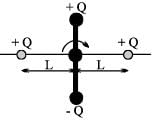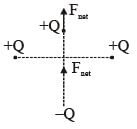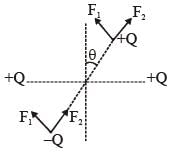JEE Exam > JEE Questions > In the diagram shown, the +Q and –Q cha...
Start Learning for Free
In the diagram shown, the +Q and –Q charges are connected by a nonconducting rod, which can freely rotate about the fixed axis passing through the centre. The other two +Q charges are fixed at the positions shown. The dipole shown is in the state of


- a)Stable equilibrium
- b)Unstable equilibrium
- c)Neutral equilibrium
- d)Non-equilibrium
Correct answer is option 'C'. Can you explain this answer?
Verified Answer
In the diagram shown, the +Q and –Q charges are connected by a n...
In eq. position, no torque acts.

After displacing by angle θ, no torque acts.
So, it is a position of neutral equilibrium.

So, it is a position of neutral equilibrium.


|
Explore Courses for JEE exam
|

|
Similar JEE Doubts
In the diagram shown, the +Q and –Q charges are connected by a nonconducting rod, which can freely rotate about the fixed axis passing through the centre. The other two +Q charges are fixed at the positions shown. The dipole shown is in the state ofa)Stable equilibriumb)Unstable equilibriumc)Neutral equilibriumd)Non-equilibriumCorrect answer is option 'C'. Can you explain this answer?
Question Description
In the diagram shown, the +Q and –Q charges are connected by a nonconducting rod, which can freely rotate about the fixed axis passing through the centre. The other two +Q charges are fixed at the positions shown. The dipole shown is in the state ofa)Stable equilibriumb)Unstable equilibriumc)Neutral equilibriumd)Non-equilibriumCorrect answer is option 'C'. Can you explain this answer? for JEE 2025 is part of JEE preparation. The Question and answers have been prepared according to the JEE exam syllabus. Information about In the diagram shown, the +Q and –Q charges are connected by a nonconducting rod, which can freely rotate about the fixed axis passing through the centre. The other two +Q charges are fixed at the positions shown. The dipole shown is in the state ofa)Stable equilibriumb)Unstable equilibriumc)Neutral equilibriumd)Non-equilibriumCorrect answer is option 'C'. Can you explain this answer? covers all topics & solutions for JEE 2025 Exam. Find important definitions, questions, meanings, examples, exercises and tests below for In the diagram shown, the +Q and –Q charges are connected by a nonconducting rod, which can freely rotate about the fixed axis passing through the centre. The other two +Q charges are fixed at the positions shown. The dipole shown is in the state ofa)Stable equilibriumb)Unstable equilibriumc)Neutral equilibriumd)Non-equilibriumCorrect answer is option 'C'. Can you explain this answer?.
In the diagram shown, the +Q and –Q charges are connected by a nonconducting rod, which can freely rotate about the fixed axis passing through the centre. The other two +Q charges are fixed at the positions shown. The dipole shown is in the state ofa)Stable equilibriumb)Unstable equilibriumc)Neutral equilibriumd)Non-equilibriumCorrect answer is option 'C'. Can you explain this answer? for JEE 2025 is part of JEE preparation. The Question and answers have been prepared according to the JEE exam syllabus. Information about In the diagram shown, the +Q and –Q charges are connected by a nonconducting rod, which can freely rotate about the fixed axis passing through the centre. The other two +Q charges are fixed at the positions shown. The dipole shown is in the state ofa)Stable equilibriumb)Unstable equilibriumc)Neutral equilibriumd)Non-equilibriumCorrect answer is option 'C'. Can you explain this answer? covers all topics & solutions for JEE 2025 Exam. Find important definitions, questions, meanings, examples, exercises and tests below for In the diagram shown, the +Q and –Q charges are connected by a nonconducting rod, which can freely rotate about the fixed axis passing through the centre. The other two +Q charges are fixed at the positions shown. The dipole shown is in the state ofa)Stable equilibriumb)Unstable equilibriumc)Neutral equilibriumd)Non-equilibriumCorrect answer is option 'C'. Can you explain this answer?.
Solutions for In the diagram shown, the +Q and –Q charges are connected by a nonconducting rod, which can freely rotate about the fixed axis passing through the centre. The other two +Q charges are fixed at the positions shown. The dipole shown is in the state ofa)Stable equilibriumb)Unstable equilibriumc)Neutral equilibriumd)Non-equilibriumCorrect answer is option 'C'. Can you explain this answer? in English & in Hindi are available as part of our courses for JEE.
Download more important topics, notes, lectures and mock test series for JEE Exam by signing up for free.
Here you can find the meaning of In the diagram shown, the +Q and –Q charges are connected by a nonconducting rod, which can freely rotate about the fixed axis passing through the centre. The other two +Q charges are fixed at the positions shown. The dipole shown is in the state ofa)Stable equilibriumb)Unstable equilibriumc)Neutral equilibriumd)Non-equilibriumCorrect answer is option 'C'. Can you explain this answer? defined & explained in the simplest way possible. Besides giving the explanation of
In the diagram shown, the +Q and –Q charges are connected by a nonconducting rod, which can freely rotate about the fixed axis passing through the centre. The other two +Q charges are fixed at the positions shown. The dipole shown is in the state ofa)Stable equilibriumb)Unstable equilibriumc)Neutral equilibriumd)Non-equilibriumCorrect answer is option 'C'. Can you explain this answer?, a detailed solution for In the diagram shown, the +Q and –Q charges are connected by a nonconducting rod, which can freely rotate about the fixed axis passing through the centre. The other two +Q charges are fixed at the positions shown. The dipole shown is in the state ofa)Stable equilibriumb)Unstable equilibriumc)Neutral equilibriumd)Non-equilibriumCorrect answer is option 'C'. Can you explain this answer? has been provided alongside types of In the diagram shown, the +Q and –Q charges are connected by a nonconducting rod, which can freely rotate about the fixed axis passing through the centre. The other two +Q charges are fixed at the positions shown. The dipole shown is in the state ofa)Stable equilibriumb)Unstable equilibriumc)Neutral equilibriumd)Non-equilibriumCorrect answer is option 'C'. Can you explain this answer? theory, EduRev gives you an
ample number of questions to practice In the diagram shown, the +Q and –Q charges are connected by a nonconducting rod, which can freely rotate about the fixed axis passing through the centre. The other two +Q charges are fixed at the positions shown. The dipole shown is in the state ofa)Stable equilibriumb)Unstable equilibriumc)Neutral equilibriumd)Non-equilibriumCorrect answer is option 'C'. Can you explain this answer? tests, examples and also practice JEE tests.

|
Explore Courses for JEE exam
|

|
Signup for Free!
Signup to see your scores go up within 7 days! Learn & Practice with 1000+ FREE Notes, Videos & Tests.
























